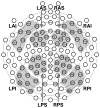Electrophysiological correlates of high-level perception during spatial navigation
- PMID: 19293100
- PMCID: PMC2704578
- DOI: 10.3758/PBR.16.2.313
Electrophysiological correlates of high-level perception during spatial navigation
Abstract
We studied the electrophysiological basis of object recognition by recording scalp electroencephalograms while participants played a virtual-reality taxi driver game. Participants searched for passengers and stores during virtual navigation in simulated towns. We compared oscillatory brain activity in response to store views that were targets or nontargets (during store search) or neutral (during passenger search). Even though store category was solely defined by task context (rather than by sensory cues), frontal electrophysiological activity in the low frequency bands (primarily in the [4-8 Hz] band) reliably distinguished between the target, nontarget, and neutral store views. These results implicate low-frequency oscillatory brain activity in frontal regions as an important variable in the study of the cognitive processes involved in object recognition, categorization, and other forms of high-level perception.
Figures



Similar articles
-
Human cortical EEG rhythms during long-term episodic memory task. A high-resolution EEG study of the HERA model.Neuroimage. 2004 Apr;21(4):1576-84. doi: 10.1016/j.neuroimage.2003.11.023. Neuroimage. 2004. PMID: 15050581
-
Memory load and display polarity in visual search performance and EEG response.Percept Mot Skills. 2010 Feb;110(1):185-94. doi: 10.2466/PMS.110.1.185-194. Percept Mot Skills. 2010. PMID: 20391884
-
Effects of repetition learning on upright, inverted and contrast-reversed face processing using ERPs.Neuroimage. 2004 Apr;21(4):1518-32. doi: 10.1016/j.neuroimage.2003.12.016. Neuroimage. 2004. PMID: 15050576
-
The categorization of natural scenes: brain attention networks revealed by dense sensor ERPs.Neuroimage. 2006 Aug 15;32(2):583-91. doi: 10.1016/j.neuroimage.2006.04.180. Epub 2006 Jun 5. Neuroimage. 2006. PMID: 16750397
-
Coordinate transformations in object recognition.Psychol Bull. 2006 Nov;132(6):920-45. doi: 10.1037/0033-2909.132.6.920. Psychol Bull. 2006. PMID: 17073527 Review.
Cited by
-
PandaEPL: a library for programming spatial navigation experiments.Behav Res Methods. 2013 Dec;45(4):1293-312. doi: 10.3758/s13428-013-0322-5. Behav Res Methods. 2013. PMID: 23549683 Free PMC article.
-
VR for Cognition and Memory.Curr Top Behav Neurosci. 2023;65:189-232. doi: 10.1007/7854_2023_425. Curr Top Behav Neurosci. 2023. PMID: 37440126
-
Neural measures of subsequent memory reflect endogenous variability in cognitive function.J Exp Psychol Learn Mem Cogn. 2021 Apr;47(4):641-651. doi: 10.1037/xlm0000966. Epub 2020 Nov 5. J Exp Psychol Learn Mem Cogn. 2021. PMID: 33151720 Free PMC article.
-
Neural biomarkers of age-related memory change.Psychol Aging. 2025 May;40(3):265-277. doi: 10.1037/pag0000876. Epub 2025 Feb 6. Psychol Aging. 2025. PMID: 39913469
-
Virtual reality in neuroscience research and therapy.Nat Rev Neurosci. 2011 Nov 3;12(12):752-62. doi: 10.1038/nrn3122. Nat Rev Neurosci. 2011. PMID: 22048061 Review.
References
-
- Chun MM. Types and tokens in visual processing: A double dissociation between the attentional blink and repetition blindness. Journal of Experimental Psychology: Human Perception and Performance. 1997;23:738–755. - PubMed
-
- Curran T. Effects of attention and confidence on the hypothesized ERP correlated of recollection and familiarity. Memory & Cognition. 2004;42:1088–1106. - PubMed
-
- Curran T, DeBuse C, Lenynes PA. Conflict and criterion setting in recognition memory. Journal of Experimental Psychology: Learning, Memory, and Cognition. 2007;33:2–17. - PubMed
Publication types
MeSH terms
Grants and funding
LinkOut - more resources
Full Text Sources
